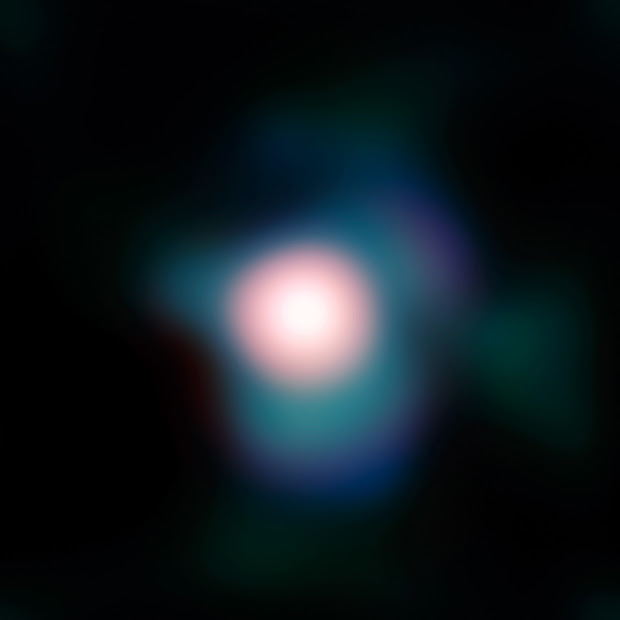Click on the image to enlarge
Image of the supergiant star Betelgeuse obtained with the NACO adaptive optics instrument on ESO's Very Large Telescope. The use of NACO combined with a so-called "lucky imaging" technique, allowed the astronomers to obtain the sharpest ever image of Betelgeuse, even with Earth's turbulent, image-distorting atmosphere in the way. The resolution is as fine as 37 milliarcseconds, which is roughly the size of a tennis ball on the International Space Station (ISS), as seen from the ground. The image is based on data obtained in the near-infrared, through different filters. The field of view is about half an arcsecond wide, North is up, East is left.
Also called Alpha Orionis, Betelgeuse is a red supergiant star marking the shoulder of the winter constellation Orion the Hunter. Astronomers believe Betelgeuse is only 10 million years old, but has evolved rapidly because of its high mass. It is thought to be a runaway star from the Orion OB1 Association, which also includes the late type O and B stars in Orion's belt-Alnitak, Alnilam and Mintaka. Currently in a late stage of stellar evolution, Betelgeuse is expected to explode as a Type II supernova, possibly within the next million years. Betelgeuse is already old for its size class and is expected to explode relatively soon compared to its age. Solving the riddle of mass-loss will be the key to knowing when a supernova may occur, an event expected anytime in the next million years. Supporting this hypothesis are a number of unusual features that have been observed in the interstellar medium of the Orion Molecular Cloud Complex, which suggest that there have been multiple supernova explosions in the recent past. Betelgeuse's suspected birthplace in the Orion OB1 Association is the probable location for such supernovae. Since the oldest subgroup in the association has an approximate age of 12 million years, the more massive stars likely had sufficient time to evolve to this stage. Also, because runaway stars are believed to be caused by supernova explosions, there is strong evidence that OB stars μ Columbae, AE Aurigae and 53 Arietis all originated with such an explosion in Ori OB1 2.2, 2.7 and 4.9 million years ago.
At its current distance from Earth, such a supernova explosion would be the brightest recorded, outshining the Moon in the night sky and becoming easily visible in broad daylight.
Professor J. Craig Wheeler of The University of Texas at Austin predicts the supernova will emit 1053 ergs of neutrinos, which will pass through the star's hydrogen envelope in around an hour, then reach the solar system several centuries later. Since its rotational axis is not pointed toward the Earth, Betelgeuse's supernova is unlikely to send a gamma ray burst in the direction of Earth large enough to damage ecosystems. The flash of ultraviolet radiation from the explosion will likely be weaker than the ultraviolet output of the Sun. The supernova could brighten to an apparent magnitude of −12 over a two-week period, then remain at that intensity for 2 to 3 months before rapidly dimming. The year following the explosion, radioactive decay of cobalt to iron will dominate emission from the supernova remnant, and the resulting gamma rays will be blocked by the expanding envelope of hydrogen. If the neutron star remnant becomes a pulsar, then it could produce gamma rays for thousands of years.
Because Betelgeuse is between 497 and 789 lightyears away from Earth, Betelgeuse may have already become a supernova centuries ago; if so, the light is still in transit.
Credit: ESO and P. Kervella










0 comment(s):
Post a Comment